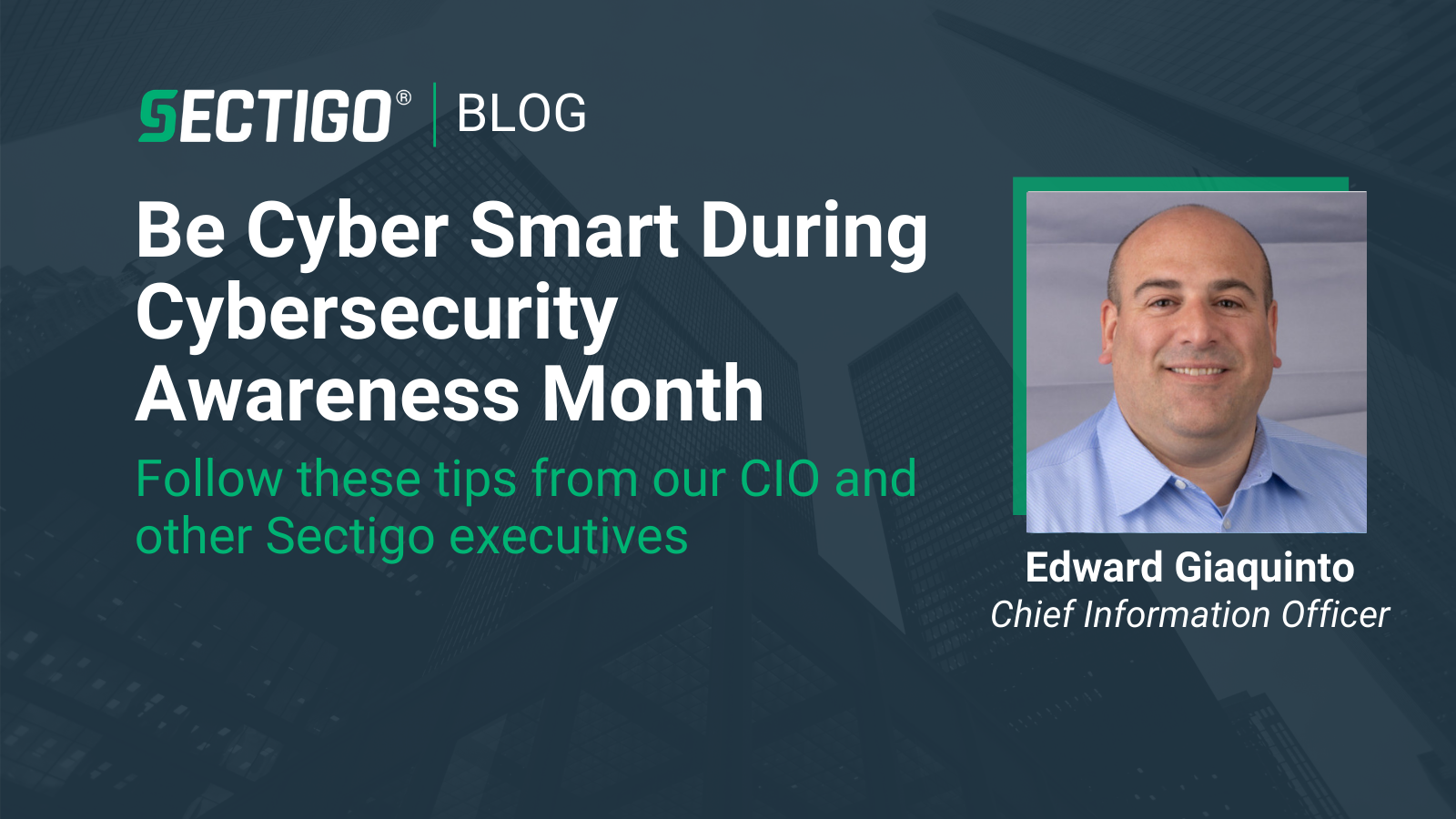Tips to Remember During Cybersecurity Awareness Month
October is upon us, and that means the beginning of another Cybersecurity Awareness Month. To say that 2020 has been an interesting year would be a vast understatement, and cybersecurity professionals have had to face down new and unexpected challenges like the widespread shift to remote work amid the COVID-19 pandemic.
Popular services like Microsoft Teams and Spotify have experienced high-profile outages due to certificate mismanagement, hacker groups have done their best to steal COVID-19 vaccine research, and the looming presidential election has once again put election security in the spotlight. Hardly a day has gone by this year without a new cybersecurity concern making headlines, and businesses and organizations across the globe are working to adapt as quickly as possible.
Sectigo has always prioritized educating the market not just on the cybersecurity challenges facing the world, but their potential solutions—and have done so this year more than ever. Whether those solutions come in the form of a new product or simply improving employees’ cyber hygiene, our goal is to help our partners and customers better understand how to keep their networks and devices safe and secure.
Below, enterprises will find some favorite highlights from our resource library, featuring tips and tricks to keep in mind during Cybersecurity Awareness Month! We hope you find them helpful, and remember: “Do your part, #BeCyberSmart.

Brush Up On the Basics
What Are Digital Signatures & How Do They Work? Digital signatures are similar to physical signatures in the sense that both are unique to the signer, except that in the case of digitally signed documents, a digital signature offers far more security and the assurance of the document’s origin, identity, and integrity. Learn more about how these signatures are used to secure networks and devices.
What Is an SSH Key? SSH keys not only improve security, but also enable the automation of connected processes, single sign-on (SSO), and identity and access management at scale. Learn about how using these keys can benefit today’s businesses.
What Is a Hardware Security Module? A Hardware Security Module is a piece of hardware that securely stores secret material such as cryptographic keys. Listen to the Root Causes hosts explain terms like HSM, Trusted Platform Module (TPM), Secure Enclave, TrustZone, and Hardware Secure Element (SE).
How Does a DDoS Attack Work? A DDoS, or distributed denial-of-service, attack is an attempt by a cybercriminal to flood a server with traffic to overwhelm its infrastructure. Learn more about what that means and how to prevent it from happening to you.
No More Zoom Bombing
Top Tips to Prevent Zoom Bombing. So-called “Zoom Bombing” was a common occurrence early on in the pandemic, and although the most commonly exploited vulnerabilities have been addressed, the ability to communicate securely remains critical for businesses. Learn how to ensure that your next teleconference won’t be invaded.
Face Down Common Attack Tactics
What are the 5 Most Common Attacks on Websites? Every day, hackers around the world are scanning the Web for vulnerable websites to target—and yours could be next. Learn about the most common attack tactics and how to defend against them.
Proceed with Caution: Tips for Avoiding Email Phishing Scams. More than 90% of data breaches start with a phishing attack. Being able to spot phishing scams starts with knowing what motivates fraudsters. Learn about the most common tactics used in email phishing and how to avoid becoming a victim.
Social Engineering: Friend or Foe? Attackers often seem unassuming and respectable, often claiming to be a new employee, a service technician, or a member of the service-providing company and may even offer credentials to support that identity. Learn to spot these attacks and avoid them.
Understand Malware
How Can a Person Inject a Malicious Script to a Website? Understanding how a website is attacked by a malicious script is important. Learn more about a problem that businesses around the world are fighting.
Can I Get Malware by Simply Visiting a Website? Learn more about the tactics that today’s cybercriminals use to get malware onto their victims’ machines. Can you get malware just by visiting a website? Find the answer to this question and more.
Get Started with Quantum-Safe Crypto
Quantum-Safe Cryptography—Surviving the Upcoming Quantum Cryptographic Apocalypse. The fundamental cryptographic algorithms now widely used to protect every facet of digital life will, within several years, be easily defeated by quantum computers. Learn more about what this means for the industry, and how cybersecurity professionals are working to update their tactics.
Six Steps for Migrating PKI Based Cybersecurity Systems to Quantum-Safe Cryptography. The rise of quantum computing will pose new challenges for the industry, and ensuring the PKI solutions can provide adequate protection in the face of quantum computing attacks is critical.
Embrace the Strength of PKI
Five Ways PKI Protects and Secures Financial Services Data. Data has become the lifeblood of the financial services industry, which makes it the most important resource to protect. Learn how to keep that valuable data secure using PKI solutions.
How to Keep Hackers Away from Tomorrow’s Smart Cities. Everything in our cities is connected, but with this connectivity come dangerous vulnerabilities. Learn how to keep today’s smart cities secure from dangerous cyberattacks.
Keeping Medical Devices, Services, and Data Safe from Cyberattacks. Particularly during the current pandemic, hospitals and medical facilities are attractive targets for would-be cybercriminals. Learn how to better protect patient data from attackers.
